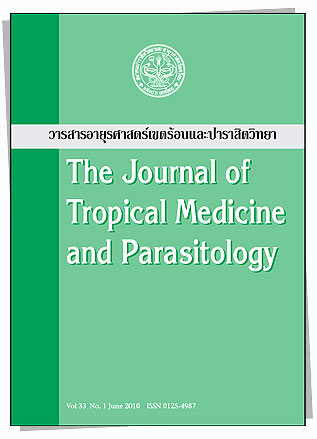Gastrointestinal Helminth Infections in Asian House Rats (Rattus tanezumi) from Northern and Northeastern Thailand
Main Article Content
Abstract
Abstract
The presence of gastrointestinal helminths (GI helminths) was investigated in 68 Asian house rats (Rattus tanezumi) trapped in various habitats: forests, upland, lowland agricultural areas and domestic places from northern and northeastern Thailand. The study revealed the rodents were infected with 11 species or taxonomic groups of parasites (2 cestodes, 8 nematodes and 1 acanthocephalan). The prevalence of infection was 66.2% (45 out of 68 rats infected). Of the GI helminths, the dominant parasites were Trichostrongylidae (33.8%) followed by Raillietina sp (20.6%), Syphacia muris (14.7%) and Hymenolepis diminuta (11.8%). Domestic habitats showed the highest prevalence of infection (23.5%) followed by upland (17.6%), lowland (16.1%) and forest habitats (8.8%). Helminth diversity was also highest in domestic habitats followed by upland, lowland and forest habitats, with 8, 7, 6 and 4 species or taxonomic groups, respectively. The prevalence of parasite infection and helminth species richness in R. tanezumi was higher in human living places than in wild habitats or agricultural areas. Host sex and maturity were not significantly found to influence the overall prevalence of helminth infection. Raillietina sp, H. diminuta and Moniliformis moniliformis, potential causes of parasitic zoonoses, were found in domestic habitats, making them a risk for human helminthiasis in this region.
Keywords: gastrointestinal helminth; rodent; Rattus tanezumi; habitat; zoonose; Thailand

